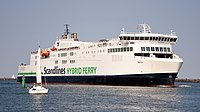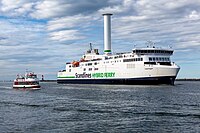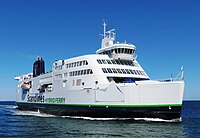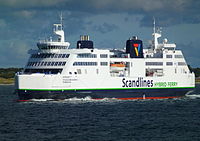Scandlines
| Company type | Private |
|---|---|
| Industry | Transport |
| Founded | 1998 |
| Founder | Danish Ministry of Transport Deutsche Bahn |
| Headquarters | , Denmark |
Area served | Baltic Sea |
Key people | Michael Guldmann Petersen {Chief Executive Officer} |
| Services | Ferries |
| Revenue | €466 million (2023) |
| €134 million (2023) | |
| Parent | First Sentier Investors (50%) 3i (35%) Hermes Investment Management (15%) |
| Subsidiaries | Scandlines Deutschland, Scandlines Danmark |
| Website | Official website |
Scandlines is a ferry company that operates the Rødby–Puttgarden and Gedser–Rostock ferry routes between Denmark and Germany.
Scandlines owns seven ferries, six of which are hybrid ferries, making Scandlines the owner of the world's largest fleet of hybrid ferries. It has two subsidiaries, Scandlines Danmark ApS and Scandlines Deutschland GmbH, which operate in the two main countries.
History

In 1903, the first railway ferry sailed between Gedser in Denmark and Warnemünde in Germany, where DSB operated the route from the Danish side in partnership with a state-owned German shipping company.[1]
A second service, the 'bird's flight line' (die Vogelfluglinie in German) between Rødby and Puttgarden was added in 1963, creating a direct route between Copenhagen and Hamburg.[1]
The company was separated from DSB in 1995, and transformed into an independent limited company called DSB Rederi, which was, in turn, rebranded Scandlines in 1997. The Scandlines brand had already been in use since 1991 on the Helsingør–Helsingborg ferry route[2] In 1998, the two shipping company partners, Danish Scandlines and German DFO, merged to form Scandlines, owned by the Danish Ministry of Transport and Deutsche Bahn.[1]
Scandlines was privatised in 2007 with 3i and Allianz Capital owning 40% each and Deutsche Seereederei 20%.[3] In 2010 Deutsche Seereederei sold its shareholding to 3i and Allianz. In 2013 Allianz sold its 49% to 3i.[4][5] In 2018 First Sentier Investors and Hermes Investment Management acquired 50% and 15% shareholdings.[6]
Between 1999 and 2015, some of Scandlines' routes were sold, including Aarhus-Kalundborg to Molslinjen, and Helsingør-Helsingborg to ForSea Ferries.
Scandlines operates two routes; Gedser to Rostock and Rødby to Puttgarden. Scandlines expects to continue operating on the Rødby–Puttgarden route despite the planned completion of the Fehmarn Belt tunnel in 2029.[7]
Ferries
Scandlines has six hybrid ferries and one freight ferry. In 2022, two ferries had a rotor sail mounted.[8]
Scandlines' ferries on Rødby-Puttgarden:
Scandlines' ferries on Gedser-Rostock:
| Name | Built | Tonnage | Passengers | Notes | Images |
|---|---|---|---|---|---|
| Berlin | 2012 | 22.319 | 1.300 | Hybrid and rotor sail |  Berlin before rotor sail |
| Copenhagen | 2012 | 22.319 | 1.300 | Hybrid and rotor sail | 
|
Freight ferry
| Name | Built | Tonnage | Passengers | Notes | Images |
|---|---|---|---|---|---|
| Kronprins Frederik | 1981 | 16.071 | 1400 | Freight & Replacement |

|
| Futura | 2024 | TBD | 140 | E-Ferry Freight |
[9][10] |
In November 2021, it was announced that the company has ordered a battery-electric ferry for the Puttgarden-Rødby route from Cemre Shipyard. The new vessel is due to enter service in 2024 and will have two-deck loading alongside a freight capacity of 66 HGVs, or some 1200 lane metres.[11]
Harbours
Scandlines owns the harbours areas in Rødby, Gedser and Puttgarden and leases an area in the harbour of Rostock.[12]
References
- ^ a b c Our history Scandilines
- ^ Hauerslev.com. DSB Færgeåret 1991. Retrieved 12 October 2023.
- ^ DAR, 2 partners to acquire Scandilines Journal of Commerce 4 April 2007
- ^ 3i acquires Allianz Capital Partners’ stake in Scandlines Allianz 5 November 2013
- ^ 3i Group control Scandilines Ships Monthly February 2014 page 11
- ^ 3i Group sells Scandilines, but re-buys stake Baltic Transport Journal 4 April 2018
- ^ TV2east.dk. Rederi opruster i kamp om Femern - køber batterifærge for over en halv milliard. Retrieved 29 June 2023.
- ^ "Norsepower Rotor Sail Installed on Scandlines Ferry". Baird Maritime. 28 May 2020. Retrieved 13 January 2023.
- ^ "NY Scandlines fragtfærge søsat".
- ^ https://www.faergenyt.dk/scandlines-bygningen-af-futura-er-gaaet-ind-i-sidste-fase/
- ^ "Scandlines orders zero-emission ferry for Puttgarden-Rødby route". Shippax SE. 9 November 2021. Retrieved 13 January 2023.
- ^ "Our ferries and harbours". Scandlines. Retrieved 13 January 2023.
External links
![]() Media related to Scandlines at Wikimedia Commons
Media related to Scandlines at Wikimedia Commons




